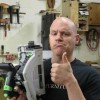I recently bought and assembled the V2 Venturi Vacuum pump kit from Joe Woodworker. I haven't used it yet, but I tested it with just the bag and it seems to work exactly as it is supposed to, so we're ready for the maiden voyage - a 3x3 table top. I'm able to detach this table top easily from the apron and base, so what I've got is just the top, a solid core with face and bottom veneer.
My question: do I need platens at all if I have enough breather mesh to cover both sides of this table? I haven't made any platens yet, and due to time constraints, I probably won't make any until I need them.
I was thinking that I would just wrap the table top in the mesh, then place it into the bag and proceed with nothing else, but I've never done this before and although I understand the purpose of the platens from a physics standpoint, I can't seem to wrap my head around their concept from a logical standpoint. In other words, if this were road engineering class, I understand the purpose of a stop sign, but for some reason, I'm having trouble selecting logical locations to place them.
Thanks!






 Reply With Quote
Reply With Quote






